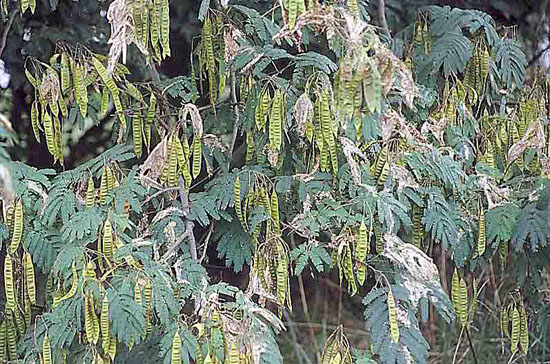Issue 6, June 3, 2013
Mimosa Webworm
Mimosa webworm is susceptible to control at this time in southern Illinois. Spraying the foliage of attacked trees with Bacillus thuringiensis kurstaki (Dipel, Thuricide), spinosad (Conserve), or labeled pyrethroid insecticide at this time should provide control. Treatment will be successful in central and northern Illinois in about two weeks.
Mimosa webworm heavily attacks silktree or mimosa, Albizia julibrissin, in southern Illinois. It is common for much of the foliage of silktrees to be brown and heavily webbed together in late summer. It also attacks honey locust throughout the state, but is only occasionally numerous enough to cause obvious aesthetic damage. When numerous, the foliage of a third or more of honey locusts will be brown in late summer.

Mimosa webworm damage.
Mimosa webworm has two generations per year in Illinois. Larvae and pupae overwinter in bark crevices and other protected locations, emerging as adult moths in spring. Larvae are greenish or brownish, slender caterpillars slightly more than one-half-inch long when fully grown. They wiggle vigorously and crawl quickly when disturbed. They web leaflets together, feeding on the webbed leaflets, causing them to turn brown. Mature larvae pupate and emerge as moths to lay a second generation of eggs on leaves damaged by the first generation larvae. This second generation is colonial, with the numerous larvae webbing entire compound leaves together, causing the damage to be very obvious.
Controlling the first generation larvae usually prevents the large, damaging, second generation larvae. Scout by looking for small numbers of leaflets webbed together on silktree and two to three leaflets webbed together on honey locust. Large numbers of these webbed leaflets containing first generation larvae warrant control. In the northern two-thirds of the state, trees close to buildings are more likely to be attacked. Larvae that crawl under siding and shingles of heated buildings are more likely to survive cold winters. In southern Illinois, larvae usually survive the winter without finding warmer sites. (Phil Nixon)
Author:
Phil Nixon